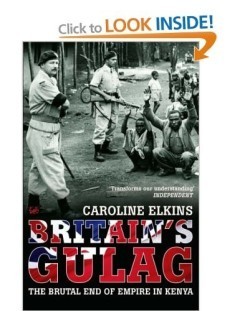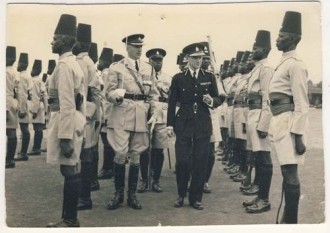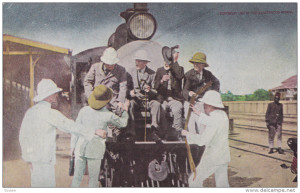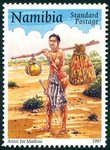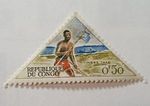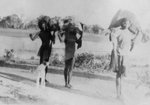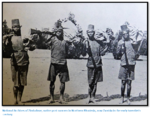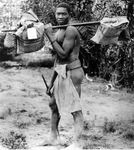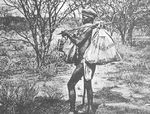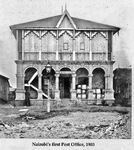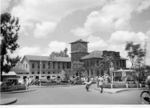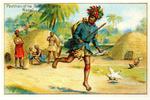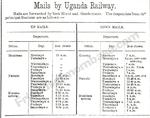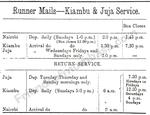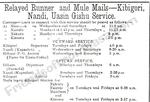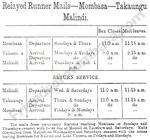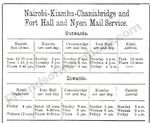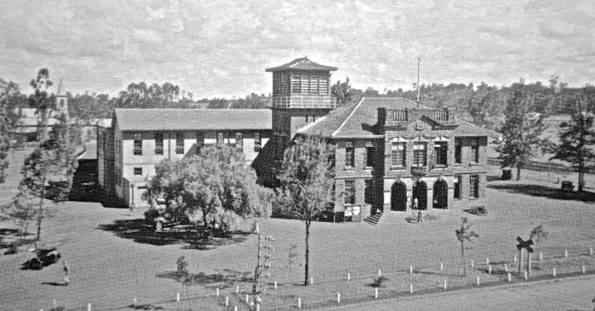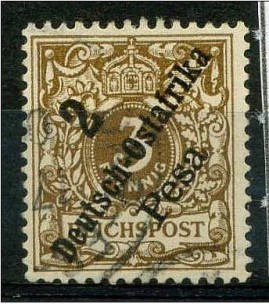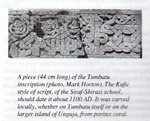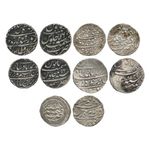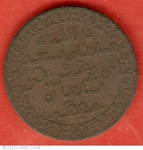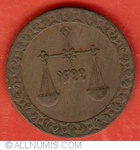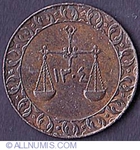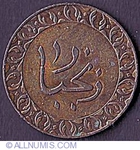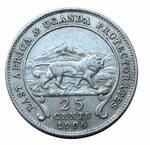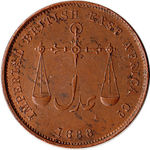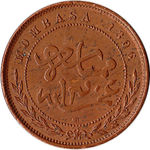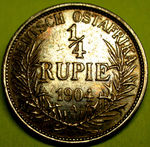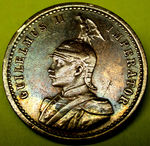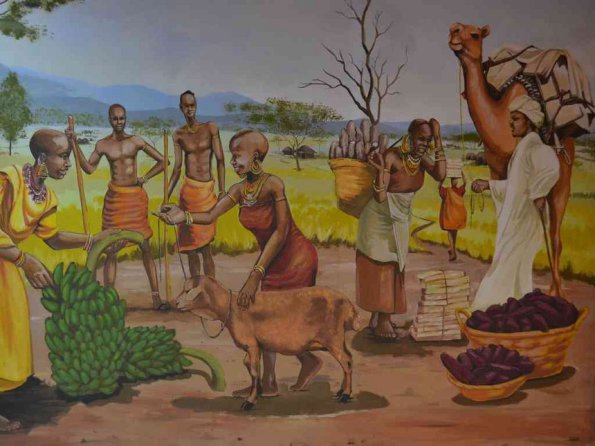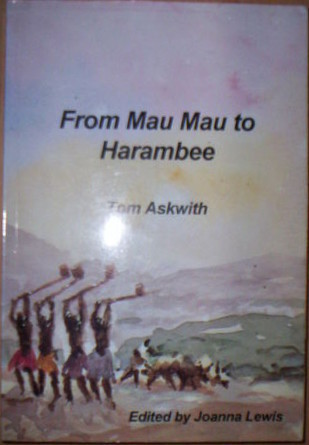British East Africa Company: 1888-1895
|
Masai and Kikuyu: to the 19th century |
|||
|
In the time before the arrival of outsiders and
the beginning of recorded history, the Masai are the dominant tribe in the region now known as Kenya. They arrive as nomadic pastoralists from the north, probably in the mid-18th century. They are
not Kenya's largest tribe (a distinction going to the Kikuyu, who live by agriculture), but the fierce reputation of the Masai warriors, engaging in frequent raids against their neighbours, gives
them a power beyond their numbers. |
|
|
|
|
A German-British carve up: 1885-1886 |
|||
|
On 7 August 1885 five German warships steam
into the lagoon of Zanzibar and train their guns on the sultan's palace. They have arrived with a demand from Bismarck that Sultan Barghash cede to the German emperor his mainland territories or face
the consequences. |
|
|
|
|
The embarrassed British consul finds himself
under orders from London to persuade the sultan to sign an agreement ceding the lion's share of his mainland territory, with the details still to be decided. In September the German gunships begin
their journey home. A joint Anglo-German boundary commission starts work in the interior. |
|
|
|
|
British East Africa Company: 1888-1895 |
|||
|
As with the areas being colonized by Rhodes at
this same period in southern Africa, the British government is reluctant to take active responsibility for the region of east Africa which is now its acknowledged sphere of interest. Instead it
assigns to a commercial company the right to administer and develop the territory. The Imperial British East Africa Company is set up for the purpose in 1888, a year ahead of Rhodes's British South Africa Company. |
|
|
|
|
It is evident to all that the development of
this region depends on the construction of a railway from the coast to Lake Victoria, but circumstances conspire to make this task far beyond the abilities of the East Africa Company. The running
sore which saps their energy and their funds is Buganda. |
|
|
|
|
A possibly dangerous confrontation between the
imperial powers is averted when the British prime minister, Lord Salisbury, proposes a deal which Berlin, remarkably, accepts. Salisbury offers the tiny and apparently useless island of Heligoland (in British possession since 1814) in return for German
recognition of British protectorates in Zanzibar, Uganda and
Equatoria (the southern province of Sudan). But Germany
derives her own benefit from the deal. Heligoland subsequently proves an invaluable naval base in two world wars. |
|
|
|
|
In January 1892 there is heavy gunfire between
and among the four hills which form Kampala. On the top of one hill is the palace of the kabaka. On another the French have completed a Catholic cathedral of wooden poles and reeds. On a third the
Protestants are building their church. On the fourth is the fort established for the company by Frederick Lugard, who is the only combatant with the advantage of a Maxim machine gun. |
|
|
|
|
In 1894 the British government declares a
protectorate over Buganda. Two years later British control is extended to cover the western kingdoms of Ankole, Toro and Bunyoro - to form, together with Buganda, the Uganda Protectorate. |
|
|
|
|
East African Protectorate: 1895-1920 |
|||
|
The early years of the protectorate include
several developments of significance in Kenya's subsequent history. One is the decision to encourage settlement in Kenya's temperate highlands by farmers of European origin (this prosperous region
subsequently becomes known as the White Highlands). The intention is to provide revenue for the railway driven northwest from Mombasa to reach Kisumu on Lake Victoria in 1901. |
|
|
|
|
The resentment of the indigenous population
against the settlers is accentuated from 1904, when a policy is introduced of settling Africans on reserves. Meanwhile a third racial group complicates the protectorate's racial unease. |
|
|
|
|
Kenya Colony: 1920-1963 |
|||
|
The establishment of the colony of Kenya brings
in its train racial hostilities. New legislation on land tenure shamelessly favours the settlers. In many areas Africans are now formally dispossessed of their land and are confined in reservations
(the Kikuyu, the largest tribe, being the main losers), while the 'white highlands' policy restricts the ownership of the best farming land to Europeans. These and other tensions are reflected in the
developing political scene. |
|
|
|
|
The Indians, enjoying a greater economic
strength, are the more adamant. As early as 1920 they turn down the offer of two seats on the legislative council, since this is not representative of the size of their community. Tension remains
high until 1927, when the Indians win the right to five seats on the council (compared to eleven reserved for the Europeans). |
|
|
|
|
In 1925 the colonial government suppresses this
first Kikuyu organization, but its members immediately regroup as the Kikuyu Central Association - of which, three years later, the young Jomo Kenyatta becomes general secretary and editor of the
organization's newspaper, Muigwithania (The Unifier). |
|
|
|
|
In 1944 the legislative council in Nairobi (the
capital since 1905) becomes the first in any east African colony to include an African member - as yet just a single and lonely representative of the ethnic majority. The number doubles to two in
1946, to four in 1948 and to eight in 1951. But these are token politicians, appointed by the colonial governor from local lists. |
|
|
|
|
Mau Mau:1952-1960 |
|||
|
In October 1952 there is a sudden outbreak of
sabotage and assassination in Kenya. The perpetrators using terrorist tactics are Kikuyu, and their ritual oaths of loyalty to their secret organization reflect the customs of Jomo Kenyatta's
political group, the Kikuyu Central Association. But the meaning of their name for themselves, Mau Mau, is at the time and remains today a mystery. |
|
|
|
|
The loss of European life is relatively slight
(about 100 people). The main victims of Mau Mau violence are other Kikuyu who refuse to support the cause and are killed as collaborators. These number perhaps 2000. Among the Mau Mau themselves as
many as 11,000 die in encounters with British forces or in British prison camps, during a guerilla war that lasts four years and is marked by atrocities on both sides. |
|
|
|
|
Independence: from1963 |
|||
|
Jomo Kenyatta is still in detention in 1960,
but his colleagues elect him president of their newly formed political party KANU (Kenya African National Union). He is released by the British in 1961. In London in 1962 he leads Kenya's delegation
in the negotiations for independence. The new nation is to include the coastal strip which until this time has been leased from the sultan of
Zanzibar. |
|
|
|
|
To many in the white community it seems a
terrifying prospect that almost unfettered power is now in the hands of a politician widely held responsible for Kikuyu violence in the Mau Mau period (not to mention his having spent two years at
Moscow University during the 1930s). |
|
|
|
|
Kenyatta is succeeded peacefully from within
the ranks of KANU by his deputy, Daniel arap Moi (not himself a Kikuyu, but from one of the smaller Kalenjin tribes). Moi continues Kenyatta's pro-western policies and his one-party rule, with little
tolerance of any form of opposition. But in the early 1990s, as in most other African countries, there is strong pressure for multiparty elections. |
|
|
|
|
The 1990s prove a difficult time. Kenya
flounders economically, there are ominous outbreaks of ethnic conflict between Kalenjin and Kikuyu, and the nation's troubles are compounded by evidence of widespread corruption. In 1997, with little
sign of Moi taking effective measures to curb these abuses, the IMF suspends its promised programme of loans. |
|||
Read more: http://www.historyworld.net/wrldhis/PlainTextHistories.asp?historyid=ad21#ixzz37AjJdzoQ
As part of East Africa, the territory of what is now Kenya has seen human habitation since the beginning of the Lower Paleolithic. The Bantu expansion from a West African center of dispersal reached the area by the 1st millennium AD. With the borders of the modern state at the crossroads of the Bantu, Nilo-Saharan and Afro-Asiatic ethno-linguistic areas of Africa, Kenya is a truly multi-ethnic state.
European and Arab presence in Mombasa dates to the Early Modern period, but European exploration of the interior began only in the 19th century. The British Empire established the East Africa Protectorate in 1895, from 1920 known as the Kenya Colony.
The independent Republic of Kenya was formed in 1964. It was ruled as a de facto single-party state by the Kenya African National Union (KANU), a Kikuyu-Luo alliance led by Jomo Kenyatta during 1963 to 1978. Kenyatta was succeeded by Daniel arap Moi, who ruled until 2002. Moi attempted to transform the de facto single-party status of Kenya into a de jure status during the 1980s, but with the end of the Cold War, the practices of political repression and torture which had been "overlooked" by the Western powers as necessary evils in the effort to contain communism were no longer tolerated. Moi came under pressure, notably by US ambassador Smith Hempstone, to restore a multi-party system, which he did by 1991. Moi won elections in 1992 and 1997, which were overshadowed by political killings on both sides
Historic events of Mombasa, one can obtain directly from Britishpathe. most recommendable for purchase, click on link marked in green:
HMS Kenya
In Mombasa (1952) Sailors from HMS Kenya marching through streets of Mombasa.
Mombasa Welcomes The Princess (1956)In
Mombasa, Princess Margaret watches dancing at Purdah ceremony...
Selected Originals - Mombasa Welcomes The Princess
(1956) Material related to newsreel story...
Duke Of Edinburgh In Mombasa (1956) Lady
Baring, Wife of Governor of Kenya, and Duke of Edinburgh in...
Ensuring A Place In Paradise (1930) Citizens of Mombasa pay homage to Allah at ceremony of "hasen...
Kenya (1953) Various shots of town, country and port of Kenya,
showing people working.
Mombassa - Gateway To Kenya (1953) Life in
Mombassa for natives. Excellent landscape panorama
Granny 93 Sets Sail (1966) The Cole family leaving
Mombassa for Ocean voyage - they are emigrating from...
Morning On Mount Kenya Reel 1 On Sleeve As Mourning On Mount
Kenya (1960) Film designed to...
The Kenya Story (1961) Travelogue showing the
wildlife, countryside, cities, and beach resorts of Kenya...
http://www.britishpathe.com/search/query/mombasa
Queen Mother’s visit in the 1950’s
Khalifa al Hina’i has very fond memories of his childhood growing up in Mombasa. “The town was pristine. It wasn’t very crowded and there was this cosmopolitan air about the place with Hindus, Arabs, Boras and Sulaimanis living together,” he recounted.
Mackinnon Road Camp, Kenya (Conditions)
HC Deb 13 April 1948 vol 449 c763
https://api.parliament.uk/historic-hansard/commons/1948/apr/13/mackinnon-road-camp-kenya-conditions
In World War
II a Fleet Air
Arm airfield was established at Mackinnon Road after the British Eastern Fleet retreated to Mombasa following the Indian Ocean raid. Airfields at Voi
and Port Reitz Airport were
also used to disperse the fleet's carrier aircraft in case of attack by the aircraft carriers of the Imperial Japanese Navy.
https://en.wikipedia.org/wiki/Mackinnon_Road
King's African Rifles
Interesting photos by Derek Kershaw
These photographs originate from the private album of WW2 SAAF fighter pilot Bob Kershaw. It was kindly made available to me by Derek Kershaw, Bob's son. I copied and placed the photographs on this web site in order to share these gems to enthusiasts and the wider public as a gesture of homage to these brave men of past glory. Please respect the copy rights of these photographs and contact me to obtain the necessary permission if you want to duplicate some of this material in other web sites or printed matter.
thanks
Tinus le Roux
Februaryl 2014
http://saafww2pilots.yolasite.com/bob-kershaw-photographs.php
http://www.air-despatch.co.uk/pages/opendoor/03/flood/kenya.htm
http://www.vintageminor.co.uk/Gilg/Gilg.html
Smithsonian-Roosevelt African Expedition
When Theodore Roosevelt retired from the presidency in 1909, he was only 50 years old. The youngest former president in American history, he was looking for adventure and for a project that would take him away from Washington, D.C., and politics. A naturalist at heart, he turned, not surprisingly, to his boyhood fascination for natural history. Three weeks after the inauguration of his successor, William Howard Taft, Roosevelt set out for British East Africa to hunt big game. The Smithsonian Institution co-sponsored the expedition. Many of the specimens were destined for the new U.S. National Museum building, then under construction on the Mall and today known as the National Museum of Natural History.
Former US President Teddy Roosevelt’s Drunken Rampage in Nairobi
http://owaahh.com/former-us-president-teddy-roosevelts-drunken-rampage-in-nairobi/
The real heroes of modern-day African postal services risked their lives delivering letters by running in the 1800s
In Ancient Africa, communication was done through music, drumming and on critical occasions, the sending of royal servants and soldiers. In times when a piece of information was very sensitive or better delivered in person, royal kings left their palaces to speak with other kings behind closed doors.
Between 1877 and the Conference of Berlin Sir William Mackinnon was allowed to enter into arrangements with the Sultan who conceded all his mainland possessions…He started the first
steamship and mail service: had helped in providing a telegram cable service to Zanzibar…etc
The interior took shape after the railways was introduced and in short six tears … before that the BEA functioning in BEA had two post offices, four agencies all on the Coast…Mombasa, Kismayu, Lamu,
Malindi, Takaungu and Wasin …
Here are Time Tables for the Runner Mails to and from-Mombasa-Wasin, Relayed Runner
Mails….Mombasa-Takaungu, Malindi…..
Runner Mails- Voi –Taveta…Runner Mails…- Kapiti –Machakos..
Mails by Uganda Railways
Nairobi-Kiambu-Chaniabridge & Fort Hall and Nyeri Mail Service..
Fort Hall-Embu-Meru- and Marsabit Mail services..
Runner Mail….Kiambu & Juja Service
Runner Mails-Eldama Revine
Runner Mail- Lumbwa-Kericho
Relayed Runner and Mule Mails-Kibigori, Nandi, Uasin Gishu Service
Runner Mails .._- Kisumu-Yala River-Mumias
Mail Services between Entebbe & Kampala...
After settling, the Europeans realised the lack of postal systems. They believed that not every piece of information could be carried by word of mouth especially because there was an obvious language barrier. As foreigners, it was also impossible for them to navigate the land well and travel with information. The German settlers in Namibia and Botswana waited for as good as two years to receive letters from neighbouring towns and their homeland.
This saw the birth of postal carriers who till today are celebrated in Southern Africa…By ELIZABETH OFOSUAH JOHNSON.
https://face2faceafrica.com/article/the-real-heroes-of-modern-day-african-postal-services-risked-their-lives-delivering-letters-by-running-in-the-1800s
POSTAL HISTORY
The first post office in the area under consideration was the German office at Lamu. The Denhardt brothers who had been trading in the area for some years organised a post for the Sultan
of Witu (Witu lies inland from Lamu).
The Imperial British East Africa Company was granted a charter in 1889 for the territory between the Juba river to the North and the Umba river to the South. The postal activities of the
Company., began in 1890. The G.P.O. in London had written the following memo on the 10 January 1889
The Directors of the Imperial British East African Company incorporated by Royal Charter have asked this department to state the terms on which it would be willing to arrange with the company for a mail service to and from Mombasa.
The British Contract Steamers on the Zanzibar line call at that port regularly, as required by the Foreign Office.
It is understood that the Company intends to establish a Post office at Mombasa and they desire to have postal relations with this Department similar to those arranged three years ago with
the British North Borneo Company and based upon the general principles of the Postal Union.
From a departmental point of view there is no reason why an arrangement should not be made with the British East African Company in the direction desired but it was necessary in the first
instance to ascertain from the Foreign Office for your information whether any political objections existed to the establishment of a quasi British Post Office at Mombasa.
The Foreign Office stated that in Lord Salisbury’s opinion the North Borneo case forms a very good precedent for dealing with the present application, and that his Lordship sees no
objection to the establishment of postal relations between this country and the British East African Company at Mombasa; but he leaves it for you to consider whether in the present disturbed
condition of affairs on the Coast, the proposed arrangements can be conveniently carried out.
Perhaps you will be good enough to signify your views as to the expediency of deferring the arrangements or otherwise.
Postal service evolution in Kenya
Whereas Tommy Woods’ general store on Victoria Street (today’s Tom Mboya Street) in Nairobi may be considered by some to have been the first formal post office in the 1890s, postal services
in Kenya date back to the 17th Century. After the Portuguese overpowered the Arabs on the East African coast, they installed a governor in Mombasa in 1592 and there is evidence of official
correspondence between the port town and the outside world from 1610. The mail was carried by ship to the Arabian peninsula and India then transmitted overland to Europe. By DOUGLAS
KIEREINI
https://www.businessdailyafrica.com/bd/lifestyle/society/postal-service-evolution-in-kenya-2206696
Ugandan Railways
Headquarters of the Railways was transferred from Kilindini in July 1899 it grew into a town, initially in 1899 the post office was in temporary accommodation near the railway
station.
A building was then erected in Victoria Street which burnt down in 1902, the contents being saved. It was rebuilt on the same site, there was deep suspicion between IBEA officials and the
railway engineers, it is historically known that IBEA were in trouble around that time, in Uganda too, IBEA Commissioner John Ainsworth — who was running a broke company and thus the Railways
authority had the uper hand and ran the show.
The G.P.O was transferred from Mombasa to Nairobi on 01st March 1909,
A new building (below) was opened on 20th October 1909 , the original building becoming the Victoria Street branch office.
Postage stamps and postal history of British East Africa
From Wikipedia, the free encyclopedia
This is a survey of the postage stamps and postal history of British East Africa.
Britain had interests in this area as early as 1824. Missionaries are known to have settled in the area in 1844. The Imperial British East Africa Company obtained a concession in 1887 to administer this area, from Sultan Bargash of the Sultanate of Zanzibar. The company started to experience financial difficulties in 1891. The situation was made more difficult in 1892 when Britain declared the Sultanate of Zanzibar part of the Congo Free Trade Zone and thus depriving the company of import duties.[1] On 1 July 1895, the British government took over the administration of this area when the company was facing bankruptcy.
https://en.wikipedia.org/wiki/Postage_stamps_and_postal_history_of_British_East_Africa
The Postal Corporation of Kenya, PCK or Posta, is the oldest parastatal in Kenya having been founded in 1901 as the Postal Services of British EA (PSBEA).
The first General Post Office (GPO) was transferred from Mombasa to Nairobi on 01 st March 1908, the new building as shown above was opened on 20th October 1909.
Victoria Street branch office in the early days...
1909 it was opened along Sixth Avenue (Now Kenyatta Avenue).
Above photo of General Post Office (GPO) in Nairobi in the 1930s.
The Holy Family Church behind on the left?
British East Africa, the Stamps and their Postal Usage, 1890-1902
Click on Stamp
British East Africa
The Stamps and Their Postal Usage, 1890-1902
Ensign of the Imperial British East Africa Company
http://www.exponet.info/exhibit.php?exhibit_ID=825&lng=EN
http://www.japhila.cz/hof/0824/index0824a.htm
http://georgekrieger.com/wp-content/uploads/2013/04/BEA-Exhibit-May-2011.pdf
East African, Stamps
The Cancellation of Kenya 1890-1963 (Postal)
Click on photo below to enlarge
The Evolution of Currency on Eastern Coast and Kenya
The presence of Indians in East Africa is well documented in the Periplus of the Erythrean Sea or Guidebook of Red Sea by an ancient Greek author written in 60 AD. The ancient Indian work the Puranas also mention the East African coast as well interior of Kenya as far as Lake Victoria, which was known as ’ Nil (Nile?) Sarover,’ Lake Nil, and knew the source the of ‘Nil’ Nile.
Indian merchant mariners, Arab seafarers, Chinese and Persian sailors, among other seafarers have all visited the East African coastline stretching from the Horn of
Africa to the port of Sofala in the south.
From the times of the Egyptian Pharaohs who hired Phoenician mariners to the pre-biblical era and after, these visitors came to trade on the African coast.
The Indians have had ancient connections not just with the East African coastline but also its hinterland. The more intrepid Indian ‘nakhoda,’ skippers, undertook caravans on foot safaris to the interior. They knew of places as far inland as Uganda. They also knew the Ruwenzori Mountains as ‘Chandragiri Shekhar,’ Moon Mountain or Mountains of the Moon.
Early currency used was “Shell” of Cypraea moneta, the money cowry
This species is most abundant in the Indian Ocean, and was collected in the Maldive Islands, in Sri Lanka, along the Malabar coast, in Borneo and on other East Indian islands, and in various parts of the African coast from Ras Hafun to Mozambique. Cowry shell money was important at one time or another in the trade networks of Africa. Battering of exchange of goods was another method of trade.
The history of the Indian rupee traces back to Ancient India in circa 6th century BCE, ancient India was one of the earliest issuers of coins in the world.
Historically, the rupee (derived from the Sanskrit word raupya), was a silver coin.
Later, the Maria Theresa Thalers was also used with other silver coins such as the rupees, used during earlier periods.
The discovery of large quantities of silver in the United States and several European colonies resulted in a decline in the value of silver relative to gold, devaluing India's standard currency. This event was known as "the fall of the rupee." This had severe consequences in the nineteenth century, when the strongest economies in the world were on the gold standard.
The East African Currency Board was established in 1919 to issue and administer the currency circulating in British East Africa.
Cairo came to assert a pivotal role between the trade of : Indian Ocean, including East Africa, and that of the mediterranean, linking with the developing European as well as North African and Byzantine markets. Increased demands for East African ivory in the 11th century are fleeted by silver and occasional gold coins from timid Egypt found at places on the Swahili coast and islands (and the beginnings of local coinages, first in silver and then in copper, the latter metal obtained from the Southern African trade).
This Egyptian direction was not the sole one. The commerce between East Africa and India also increased, and continued doing so until the 16th century (when the Portuguese intervened). So did that with China, although this was mostly indirect. Chinese celadon and porcelain - whose broken pieces are common on old Swahili town sites, where these fine bowls had been used to decorate mosques, tombs and houses among other purposes - were transhipped at one or more intermediate ports (such as Malacca, Cambay, Oman and Aden). African ivory conversely reached China by stages.
Only very rarely did actual Chinese ships visit Africa. One famous exception was about 1420 AD, an occasion used by the Sultan of Malindi - one of the principal Swahili states of the time, which probably combined the fair city and palace of Gedi - to send a distinctive gift to the Emperor of China. This ‘celestial animal’, as it was recognised at the other end, has been immortalised on Chinese silk (over).
Earlier Indian Silver Coins
https://www.google.co.uk/search?q=silver+rupee&biw=1366&bih=655&tbm=isch&tbo=u&source=univ&sa=X&ei=a3roVNOKOYGN7Qbt7YHIBw&ved=0CEAQsAQ&dpr=1#imgdii=_
Coins of British India
http://en.wikipedia.org/wiki/Coins_of_British_India
In 1888 the Imperial British East Africa Company (IBEAC) which was based in Bombay was given a charter by Queen Victoria to trade in East Africa. In penetrating East Africa the IBEAC utilized the laws and personnel of Government of India as well as Indentured Indian Labour. From 1892 onwards the Indian Penal and Civil codes applied, and judicial appeals were heard in the Court of Bombay. Indian commercial laws, the Stamp, Designs, Insolvency acts were adopted and the Indian Rupee was the East African currency until 1920. Hindi words were absorbed into Swahili and East African English. The date 1306 is the Muslim date equivalent to 1888. Summary: 1 Pice, Issued by, Imperial British East Africa Company, Mombasa, Kenya, 1888 AD, 1306 AH Minted by Calcutta Mint, India. Statement Of Significance: Between 1886 and 1895 The Imperial British East Africa Company had administrative rights in East Africa around Zanzibar. In 1887 the Sultan of Zanzibar ceded control over the port of Mombasa to British administration and the company took control. In 1888 it had coins struck by The Mint, Birmingham in terms British Indian rupees and fractions. In 1895 a British Protectorate was proclaimed over all of the companies territories with administration under the British government. The rupee remained the standard coin of the new Protectorate, formally recognised by an Order in Council dated 19 May 1898.
World paper money - British East Africa 100 Shillings or 5 Pound banknote of 1955, issued by the East African Currency Board.
Obverse: Portrait of Queen Elizabeth II. Value in shillings written in English, Arabic, and Gujarati. Value in pounds written in English only.
Reverse: African Lion in front of mountain.
Printed by Thomas de la Rue, London.
The East African Currency Board.
The East African Currency Board was established in 1919 to issue and administer the currency circulating in British East Africa. The areas in which the Currency Board operated were Tanganyika, Zanzibar and Pemba, Kenya, Uganda and British Somaliland. Until the advent of the East African Currency Board, the Indian rupee had been the currency of these protectorates, colonies and mandates. The first issue of the East African Currency Board had been preceded by an issue of rupees under the authority of the Government of the East Africa Protectorate in 1905. (The Protectorate consisted of the area now constituting Kenya.) The East African Currency Board issued its first currency in 1920. The initial issue of a 1-rupee note, was followed by an issue of florin notes in the same year and in the following year the first shilling notes were issued.
http://www.worldbanknotescoins.com/2010/05/british-east-african-banknotes-100.html
1 Pice (IBEA Coinage)
1306 (1888-1889)
The Imperial British East Africa Company (IBEAC) set up a trading post in Mombasa in 1885 following the Heligoland-Zanzibar Treaty between Britain and the
German Empire. Mombasa was part of the Sultanate of Zanzibar before that but was by no means powerful enough to stop the British and Germans occupying the Swahili coast. The IBEAC introduced the
Rupee which was equal to the Indian Rupee and subdivided in 16 Annas of each 4 Pice.
The Imperial British East Africa Company (IBEAC) set up a trading post in Mombasa in 1885, In 1888 the Imperial British East Africa Company (IBEAC) which was
based in Bombay was given a charter by Queen Victoria to trade in East Africa.
In penetrating East Africa the IBEAC utilized the laws and personnel of Government of India as well as Indentured Indian Labour. From 1892 onwards the Indian Penal and Civil codes applied, and
judicial appeals were heard in the Court of Bombay. Indian commercial laws, the Stamp, Designs, Insolvency acts were adopted and the Indian Rupee was the East African currency until
1920.
Hindi words were absorbed into Swahili and East African English. The date 1306 is the Muslim date equivalent to 1888. Summary: 1 Pice, Issued by, Imperial
British East Africa Company, Mombasa, Kenya, 1888 AD, 1306 AH Minted by Calcutta Mint, India.
The IBEAC introduced the Rupee which was equal to the Indian Rupee and subdivided in 16 Annas of each 4 Pice.
1/4 Rupie (4 Annas)…. 4 annas=1 Pice….
From 1897 when 1 Pice was introduced to 1920 when currency system was changed to Florin, the Rupee remained the currency of the Protectorate. Coins denominated in Cents, introduced in 1906, were also under the Rupee system and formed 1/100th of a Rupee.
In the early 1900’s £1 sterling was fluctuating around 16.37 rupees….
Early Currencies, Trade and Exchange
More on Periplus of the Erythrean Sea is on Kersi Rustomji's page, under Migration/Rich Cultures
East Africa (British) banknotes
East African paper money catalogue and East African currency history
The coin that could tear up Australian history: Scientists probe African copper piece found on a beach which could show Portugal reached the continent 250 years before Captain Cook
- The coin discovered last year could be 1,000 years old and come from Tanzania
- It has been suggested that Portuguese seafarers brought it to Australia in 1515
- That would make them probably the first Europeans to reach Australian land
https://www.dailymail.co.uk/news/article-7021779/The-coin-tear-Australian-history.html
Historic illustrations of Different coins used under the Sultanate
Indian Coins
https://www.baldwin.co.uk/media/cms/auction-archive/auction-71/Indian%20Coins%20Lots%201243-1488.pdf
East African Currency (Tanzania)
The East African shilling was no longer officially pegged to the pound, hence the 20 shilling banknote did not have dual values any more. 5 EA Shilling.
In Mid-1920, the British government introduced a common East African currency of the East African Florin. Florin bank notes were in denominations of 1, 5, 10, 20, 50, 100 and 500 florins, with the 10 florins and above also carrying the denomination in pounds (1, 2, 5, 10 and 50). This currency did not last more than six months, so very few banknotes were released.
After about six months, in .. 1921, the East African Shilling was introduced to replace the East African Florin. The EA shilling had a value of 20 EA Shillings per British Pound, and it was pegged to the pound. For that reason, all 20 EA Shilling banknotes had dual values, of 20 EA Shillings and 1 pound. All banknotes were written in English, Arabic and in Amharic. Two designs of the EA Shilling banknotes were issued; the first design lasted from 1921 to 1958 during the reigns of King George V(1910-1936), King Edward VIII(1936-1936), King George VI (1936-1952) and Queen Elizabeth II (1952-Todate). The face had a picture of the King and back had a picture of lion behind Mount Kenya.
http://kichuguu.wordpress.com/2007/09/03/tanzania-curreny-banknotes-1/
http://rodsell.com/enotes/eastafrica.htm
http://africanbanknotes.com/eastafrica.php
The Evolution of Currency in Kenya
The Evolution of Currency in Kenya
A History of Currency in East Africa from 1895
A History of Currency in East Africa from 1895
Arab traders travelling through East Africa’s interior in search of ivory, slaves and other goods, were the first to introduce money as an alternative to the cumbersome salt bars normally used as payment.
The currency introduced by the Arabs was an assortment of foreign coins which reflected the multi-national nature of the Indian Ocean sea trade. There were Indian rupees and annas, pice bronze coins, British florins, and silver Maria Theresa thalers that originated from Austria.
http://www.the-star.co.ke/news/2016/11/01/a-history-of-currency-in-east-africa-from-1895_c1446591


